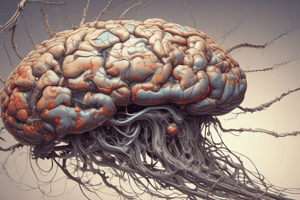Podcast
Questions and Answers
Which of the following is a primary focus of research within the biological model of abnormal psychology?
Which of the following is a primary focus of research within the biological model of abnormal psychology?
- The influence of societal expectations on individual behavior.
- Unconscious conflicts stemming from early childhood experiences.
- Malfunctioning brain circuits as the key to psychological disorders. (correct)
- The impact of distorted thought patterns on emotional well-being.
A patient with a severe, treatment-resistant mental disorder might be considered for which biological treatment option as a last resort?
A patient with a severe, treatment-resistant mental disorder might be considered for which biological treatment option as a last resort?
- Group therapy sessions.
- Antianxiety drug therapy.
- Cognitive restructuring.
- Psychosurgery. (correct)
What is a significant limitation of the biological model in explaining abnormal behavior?
What is a significant limitation of the biological model in explaining abnormal behavior?
- It fails to acknowledge the potential role of genetic factors.
- It overlooks the influence of environmental and psychological factors. (correct)
- It lacks empirical evidence to support its claims.
- It cannot explain the effectiveness of drug therapies.
According to the psychodynamic model, what primarily determines a person's behavior?
According to the psychodynamic model, what primarily determines a person's behavior?
A therapist using the psychodynamic model might focus on which aspect of a patient's experience?
A therapist using the psychodynamic model might focus on which aspect of a patient's experience?
What is a primary criticism of the psychodynamic model?
What is a primary criticism of the psychodynamic model?
Which biological treatment involves direct or indirect brain stimulation, often used for severe, treatment-resistant disorders?
Which biological treatment involves direct or indirect brain stimulation, often used for severe, treatment-resistant disorders?
What is a key strength of the psychodynamic model in understanding abnormal functioning?
What is a key strength of the psychodynamic model in understanding abnormal functioning?
Which of the following is NOT a core principle shared between behavioral and cognitive perspectives in understanding psychological abnormality?
Which of the following is NOT a core principle shared between behavioral and cognitive perspectives in understanding psychological abnormality?
In cognitive-behavioral therapy (CBT) for social anxiety disorder, what is the MOST likely order of interventions?
In cognitive-behavioral therapy (CBT) for social anxiety disorder, what is the MOST likely order of interventions?
A therapist is working with a client who has a phobia of dogs. If the therapist teaches the client relaxation techniques and then gradually exposes them to images, videos, and eventually real dogs, this is an example of:
A therapist is working with a client who has a phobia of dogs. If the therapist teaches the client relaxation techniques and then gradually exposes them to images, videos, and eventually real dogs, this is an example of:
Which of the following is a potential limitation of cognitive-behavioral therapies (CBT)?
Which of the following is a potential limitation of cognitive-behavioral therapies (CBT)?
The sociocultural model considers which of the following factors when examining abnormal behavior?
The sociocultural model considers which of the following factors when examining abnormal behavior?
What is the primary focus of the family-social perspective within the sociocultural model?
What is the primary focus of the family-social perspective within the sociocultural model?
Which approach directly aims to improve treatment outcomes for marginalized populations by increasing therapist sensitivity to cultural issues and incorporating cultural morals and models?
Which approach directly aims to improve treatment outcomes for marginalized populations by increasing therapist sensitivity to cultural issues and incorporating cultural morals and models?
What does 'intersectionality' refer to in the context of the multicultural model?
What does 'intersectionality' refer to in the context of the multicultural model?
Which of the following is a significant challenge in assessing the sociocultural model's impact on abnormal behavior?
Which of the following is a significant challenge in assessing the sociocultural model's impact on abnormal behavior?
A community-based program aims to provide job training and housing assistance to individuals recently released from prison. This initiative represents which type of prevention?
A community-based program aims to provide job training and housing assistance to individuals recently released from prison. This initiative represents which type of prevention?
What is the defining characteristic of the developmental psychopathology perspective?
What is the defining characteristic of the developmental psychopathology perspective?
In the context of developmental psychopathology, what does the principle of 'equifinality' suggest?
In the context of developmental psychopathology, what does the principle of 'equifinality' suggest?
Two children experience the loss of a parent at a young age. One child develops resilience and thrives, while the other struggles with depression and anxiety into adulthood. This scenario BEST illustrates the principle of:
Two children experience the loss of a parent at a young age. One child develops resilience and thrives, while the other struggles with depression and anxiety into adulthood. This scenario BEST illustrates the principle of:
Which perspective emphasizes the importance of understanding a person's cultural background and social identities to provide effective treatment?
Which perspective emphasizes the importance of understanding a person's cultural background and social identities to provide effective treatment?
A therapist is working with a client who experienced childhood trauma. The therapist is interested in understanding how this trauma has affected the client's development across different life stages and how it interacts with other factors, such as social support and coping mechanisms. Which perspective is the therapist MOST likely using?
A therapist is working with a client who experienced childhood trauma. The therapist is interested in understanding how this trauma has affected the client's development across different life stages and how it interacts with other factors, such as social support and coping mechanisms. Which perspective is the therapist MOST likely using?
Flashcards
Biological Model
Biological Model
Views abnormal behavior as illness caused by malfunctioning parts of the organism, focusing on brain anatomy or chemistry.
Brain Anatomy & Circuitry
Brain Anatomy & Circuitry
Problems in brain structure (size differences) or circuits (connection differences) are linked to psychological disorders.
Genetic Influence
Genetic Influence
Genes can predispose individuals to mental disorders, often through a combination of multiple genes.
Drug Therapy
Drug Therapy
Signup and view all the flashcards
Brain Stimulation
Brain Stimulation
Signup and view all the flashcards
Psychodynamic Model
Psychodynamic Model
Signup and view all the flashcards
Psychodynamic Strengths
Psychodynamic Strengths
Signup and view all the flashcards
Psychodynamic Weaknesses
Psychodynamic Weaknesses
Signup and view all the flashcards
Cognitive-Behavioral Model
Cognitive-Behavioral Model
Signup and view all the flashcards
Classical Conditioning
Classical Conditioning
Signup and view all the flashcards
Exposure Therapy
Exposure Therapy
Signup and view all the flashcards
Operant Conditioning
Operant Conditioning
Signup and view all the flashcards
Modeling
Modeling
Signup and view all the flashcards
Cognitive Restructuring
Cognitive Restructuring
Signup and view all the flashcards
Sociocultural Model
Sociocultural Model
Signup and view all the flashcards
Family-Social Model
Family-Social Model
Signup and view all the flashcards
Group Therapy
Group Therapy
Signup and view all the flashcards
Family Therapy
Family Therapy
Signup and view all the flashcards
Couple-Marital Therapy
Couple-Marital Therapy
Signup and view all the flashcards
Community Treatment
Community Treatment
Signup and view all the flashcards
Multicultural Model
Multicultural Model
Signup and view all the flashcards
Intersectionality
Intersectionality
Signup and view all the flashcards
Equifinality
Equifinality
Signup and view all the flashcards
Multifinality
Multifinality
Signup and view all the flashcards
Study Notes
- There are various models of abnormality that explain how abnormal psychology is conceptualized.
The Biological Model
- Conceptualizes abnormal psychology as an illness caused by malfunctioning parts of the organism.
- Focuses on problems in brain anatomy or brain chemistry.
- Current research emphasizes brain circuits rather than single brain areas or chemical dysfunctions.
- Brain circuits involve neurotransmitters, structures, and their functions.
- Proper interconnectivity within brain circuit structures are crucial.
- Size differences in brain structure can contribute to abnormality.
- Differences in connections within brain circuitry can lead to abnormality.
- Genetics play a role in mental disorders.
- Multiple genes often combine to produce dysfunctional actions and reactions.
- Drug therapy is the most common biological treatment.
- Brain stimulation is used in severe, treatment-resistant disorders.
- Psychosurgery is brain surgery for mental disorders and is the least common treatment.
- Antianxiety drugs, antidepressants, antibipolar drugs, and antipsychotic drugs are common drug therapies.
- Brain stimulation approaches include electroconvulsive therapy (ECT), transcranial magnetic stimulation (TMS), vagus nerve stimulation (VNS), and deep brain stimulation.
- Strengths include respect in the field, new information, and effective treatments.
- Weaknesses include excluding non-biological factors and the potential for undesirable effects.
The Psychodynamic Model
- Sigmund Freud developed the theory of psychoanalysis.
- Human behavior is determined by unconscious psychological forces.
- Abnormal symptoms result from conflict among these forces.
- It was the first to recognize psychological theories and systematic treatment for abnormality.
- Abnormal functioning is nested in the same processes as normal functioning.
- It may be helpful to persons with long-term, complex disorders.
- Weaknesses include unsupported ideas, difficulty to research, non-observable concepts.
The Cognitive-Behavioral Model
- Focuses on maladaptive behaviors and/or cognitions.
- Shares key principles between behavioral and cognitive perspectives.
- Uses conditioning to change unhelpful behaviors.
- Classical conditioning employs exposure therapy.
- Operant conditioning uses behavioral activation.
- Therapists act as teachers, replacing problematic behaviors with helpful ones.
- Centers on identifying, challenging, and changing unhelpful thinking processes.
- Identifies inaccurate assumptions, attitudes, and illogical thinking.
- Therapists help clients challenge negative thoughts, biased interpretations, and errors in logic.
- Therapists guide clients to new ways of thinking daily.
- Most modern theories and therapies interweave behavioral and cognitive components.
- Example: Social anxiety disorder involves unhelpful thoughts and avoidance behaviors. Exposure therapy is a cognitive-behavioral therapy that challenges unhelpful cognitions and provides graduated exposure to feared situations
- Strengths include efficacy, broad appeal, clinical usefulness, uniquely human process focus, and effective therapies.
- Weaknesses include an undetermined role of cognition, ineffectiveness with everyone, and neglect of early life experiences.
- Cognitions and behaviors do not occur in a vacuum.
The Sociocultural Model
- Abnormal behavior includes social and cultural forces that influence an individual.
- Proponents concentrate on forces that operate directly on individuals.
- Considers family relationships, social interactions, and community events.
- Psychological problems emerge and are best treated in family and social settings.
- Perspective spurred the growth of group, family, couple-marital, and community treatment.
- Group therapy includes support, self-help, and peer groups.
- Family therapy uses a family systems approach.
- Community treatment includes primary and secondary prevention.
- All behavior and treatment are best understood in the context of culture, cultural values, and external pressures.
- VS the more direct, individually-based influences addressed in the family-social perspective.
- Cultural intersectionality examines how memberships across multiple cultural groups shape experiences.
- Poor treatment outcomes for members of ethnic and racial minority groups.
- Therapist effectiveness with minority patients is enhanced via sensitivity to cultural issues, and inclusion of cultural morals and models.
- Strengths include added clinical understanding, increased awareness of clinical and social roles.
- Weaknesses include difficulty in interpretation of research and the inability to predict abnormality in specific individuals.
Developmental Psychopathology Perspective
- Uses an integrative framework to understand adaptive and maladaptive human functioning.
- Emphasizes time and development to explain psychological disorders.
- Equifinality refers to different factors leading to similar outcomes.
- Multifinality refers to similar factors leading to different outcomes.
Studying That Suits You
Use AI to generate personalized quizzes and flashcards to suit your learning preferences.




